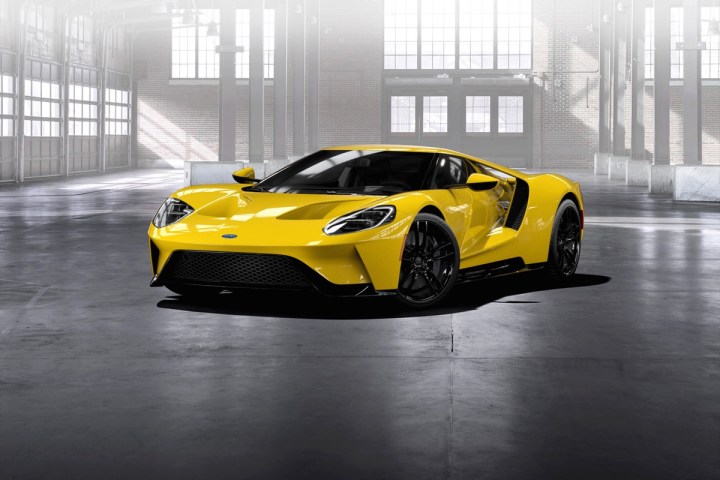
The 2017 Ford GT won’t run out of breath until 217 mph, and though Ford is still being coy about its 0 to 60 mph time, the GT is certain to come in under 3.0 seconds. The finalized curb weight is 3,054 lbs, which is notably heavier than the 2,712-lb McLaren 675LT. Quick to address the difference in heft, Ford has declared its car is quicker around a circuit than both the McLaren and a Ferrari 458 Speciale.
Though the Ford GT uses a smaller, lower-displacement motor than many of its rivals, it returns an mpg of just 11 city, 18 highway, and 14 combined. That’s so lousy that the V10-motivated Dodge Viper scores better by EPA’s standards.
The Ford GT gets a fancy digital driver display
Ford will indulge in the recent trend of digital driver displays with its halo GT model. Replacing a traditional analog gauge cluster will be a vibrant 10-inch screen that can be reconfigured based on five driving modes: Normal, Wet, Sport, Track, and V-Max. Each mode prioritizes different information based on driving conditions, and the driver toggles between them using controls on the steering wheel.
The display itself was designed in concert with Conjure, which handled graphical design, and Pektron, which was responsible for the design of the electronics. Ford says it even asked racing driver Scott Maxwell for some feedback. Maxwell works for Multimatic, the Canadian motor sports firm charged with actually building the GT on a special assembly line in Markham, Ontario.
The first GT, painted black with orange racing stripes, was driven off the line by Ford Chief Technical Officer and performance czar Raj Nair in December. According to The Detroit News, that car will go to Ford chairman Bill Ford Jr., while the second GT will go to CEO Mark Fields. Being the boss has its perks, apparently.
Ford will add two more years of GT production
After closing the application process for Ford’s initial batch of 500 GT models, the automaker announced it will extend production another two years, meaning another 500 units are up for grabs (provided you have $400,000 in hand).
The third year of GT production will be set aside for buyers that were wait-listed during the first round of applications. Others can apply for the fourth year of production, but Ford won’t begin accepting applications until early 2018. The Ford GT will be founded on exclusivity, similar to Ferrari’s tactic with its most expensive/highest-performing models. Even with 1,000 total cars on the table, thousands of applicants will soon get a rejection email from Ford.
The 2017 Ford GT sold out for two years in 30 days
Ford announced it has 6,506 applications for the 500 Ford GT units it will produce in the first production run. The production cycle will last for two years with only 250 cars built each year.
The application process required filling out a questionnaire that asked about how the car was going to be used. Ford wants people who buy the GT to actually drive it, not resell for a quick profit. They also don’t want investors to just stash them away looking for huge gains years down the road.
The next step for the fast-acting 6,506 applicants is a further screening process based on how people answered the questionnaire. Ford has said they will let everyone on the list know within 90 days whether they made the cut.
For those lucky 500 who get confirmed orders, the first deliveries will be later this year. Firm prices haven’t been announced, but you can expect them to be north of $400,000. For that hefty pile of cash, the teardrop-shaped, carbon-fiber-bodied supercar will make 600-plus horsepower with its 3.5 liter EcoBoost V6 engine. The only transmission is a 7-speed dual clutch automatic.
Editors' Recommendations
- Your car insurance company knows more about you than you think
- Everything you need to know about the GMC Hummer EV
- Check out the electric Ford Mustang Mach E before you’re supposed to see it
- Ford and Holoride have a VR message you need to deliver to Frankenstein
- 49,000 UAW workers are striking against GM. Here’s what you need to know


